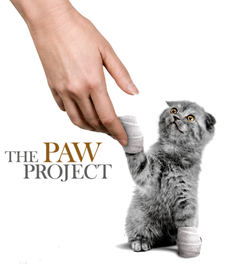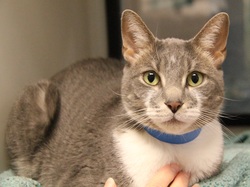
By Karen Zamel, SJAA Volunteer
As a life-long cat-lover, I always felt that declawing our feline friends was wrong, but I didn’t know why. So, I went to a leading expert to get the facts. Dr. Jennifer Conrad, DVM, founder and director of The Paw Project, recently explained why declawing is a painful, unnecessary and life-altering procedure, and why The Paw Project is working to abolish it. Sincere thanks to Dr. Conrad for allowing us to interview her on this important topic.
As a life-long cat-lover, I always felt that declawing our feline friends was wrong, but I didn’t know why. So, I went to a leading expert to get the facts. Dr. Jennifer Conrad, DVM, founder and director of The Paw Project, recently explained why declawing is a painful, unnecessary and life-altering procedure, and why The Paw Project is working to abolish it. Sincere thanks to Dr. Conrad for allowing us to interview her on this important topic.
 An alternative - Softpaws.com
An alternative - Softpaws.com Q: Is the ability to “scratch” an important part of a cat’s health?
Dr. Conrad: Scratching behavior is an essential part of a cat's well-being. Not only does it strengthen muscles and keep the claws healthy, it also gives a cat a way to alleviate anxiety by marking territory. Cats are territorial. They need to mark their space. We need to allow them the ability to secure their homes. If they can't do it by scratching things, they might resort to marking their territory with urine.
Q: What is involved in the declawing process?
Dr. Conrad: Declawing is a misnomer. The surgery should be called de-knuckling. Declawing is the amputation of the last bone in a cat's toes. It is the same as amputating the last bone in each of human fingers. It is not a fancy manicure that only a vet can do. A manicure is about as much like declawing as a haircut is like decapitation.
Q: What are the consequences or the after-effects of this process on a cat?
Dr. Conrad: Very often, a declawed cat will come home from the surgery and go, as he always did, to use the litter box. After stepping in the gravely sand and feeling the pain on what's left of the recently amputated toe nubs, he may forever associate the box with that excruciating pain, and never use the box again. Declawed cats also quickly learn that their paws, once formidable modes of protection, have been rendered useless and therefore, must protect themselves by resorting to biting.
The truth of the matter is that declawed cats, because of the behavior problems they get from being declawed (litter box avoidance and biting) lose their homes at a rate of about 2:1 compared to cats with normal paws.
So, here's the kicker: many people say that they "would rather have the cat declawed than have it lose its home." This sounds reasonable until the reality sets in: Declawing does not ensure that the cat gets to stay in its home at all! It seems to be the exact opposite. If someone is intolerant of the cat scratching the couch, then that person is going to be really intolerant of the cat peeing all over everything and biting people. The bottom line is that it is not declaw or death, it is declaw and then death for a lot of animals. The Paw Project is trying to make people realize that the better option is humane alternatives to declawing.
The other argument we often hear is that declawing a cat is "necessary to protect human health in the case of immuno-compromised people." It is well established that declawed cats bite more than clawed cats. Ask any groomer or vet tech. It is also well established that a cat bite can be severely deleterious to people with compromised immune systems or even those with normal immune systems. So by declawing the cat, the veterinarian who thought s/he was protecting human health is actually putting human health in greater jeopardy.
By the way, the Centers for Disease Control, the National Institutes of Health, the U.S. Public Health Service and the Infectious Diseases Society of America have a joint position statement for people living with HIV/aids. It says declawing their cats is not advised.
Declawing is illegal or considered unethical in much of the rest of the world. People seem to be able to coexist with cats and their claws everywhere else. Why can't we in the US and Canada?
Dr. Conrad: Scratching behavior is an essential part of a cat's well-being. Not only does it strengthen muscles and keep the claws healthy, it also gives a cat a way to alleviate anxiety by marking territory. Cats are territorial. They need to mark their space. We need to allow them the ability to secure their homes. If they can't do it by scratching things, they might resort to marking their territory with urine.
Q: What is involved in the declawing process?
Dr. Conrad: Declawing is a misnomer. The surgery should be called de-knuckling. Declawing is the amputation of the last bone in a cat's toes. It is the same as amputating the last bone in each of human fingers. It is not a fancy manicure that only a vet can do. A manicure is about as much like declawing as a haircut is like decapitation.
Q: What are the consequences or the after-effects of this process on a cat?
Dr. Conrad: Very often, a declawed cat will come home from the surgery and go, as he always did, to use the litter box. After stepping in the gravely sand and feeling the pain on what's left of the recently amputated toe nubs, he may forever associate the box with that excruciating pain, and never use the box again. Declawed cats also quickly learn that their paws, once formidable modes of protection, have been rendered useless and therefore, must protect themselves by resorting to biting.
The truth of the matter is that declawed cats, because of the behavior problems they get from being declawed (litter box avoidance and biting) lose their homes at a rate of about 2:1 compared to cats with normal paws.
So, here's the kicker: many people say that they "would rather have the cat declawed than have it lose its home." This sounds reasonable until the reality sets in: Declawing does not ensure that the cat gets to stay in its home at all! It seems to be the exact opposite. If someone is intolerant of the cat scratching the couch, then that person is going to be really intolerant of the cat peeing all over everything and biting people. The bottom line is that it is not declaw or death, it is declaw and then death for a lot of animals. The Paw Project is trying to make people realize that the better option is humane alternatives to declawing.
The other argument we often hear is that declawing a cat is "necessary to protect human health in the case of immuno-compromised people." It is well established that declawed cats bite more than clawed cats. Ask any groomer or vet tech. It is also well established that a cat bite can be severely deleterious to people with compromised immune systems or even those with normal immune systems. So by declawing the cat, the veterinarian who thought s/he was protecting human health is actually putting human health in greater jeopardy.
By the way, the Centers for Disease Control, the National Institutes of Health, the U.S. Public Health Service and the Infectious Diseases Society of America have a joint position statement for people living with HIV/aids. It says declawing their cats is not advised.
Declawing is illegal or considered unethical in much of the rest of the world. People seem to be able to coexist with cats and their claws everywhere else. Why can't we in the US and Canada?
 Jethro is a declawed kitty*
Jethro is a declawed kitty* Q: When and why did declawing become mainstream?
Dr. Conrad: Declawing cats began with dog fighting. Apparently, declawing was used to render cats as defenseless bait for dogs forced to engage in this cruel practice. Veterinarians first began reporting declawing as a way to prevent damage to sofas in the 1950s. It gained momentum in the US and Canada. Most other countries find it cruel.
Q: Is it requested as much as it used to be?
Dr. Conrad: In certain parts of the country, yes. The veterinary literature says that 25% of American cats are declawed. That means over 22 million cats.
Q: How do veterinarians who don’t agree with the practice deal with requests for declawing?
Dr. Conrad: Most people who request declawing are completely unaware that it is the wrong thing to do for the cat. If a vet educated these people, they wouldn’t choose to put their beloved cats through it. They just have to be educated about all the humane alternatives to declawing.
Q: How can pet owners cope with cats scratching in undesired areas? How can we allow a cat to scratch, but on more acceptable surfaces?
Dr. Conrad: Cats need to scratch. Pay attention to what they're scratching on. If it is a table leg, get your cat a wood scratching post; if it is the carpet, get a carpet post. Let the cat choose. Posts have to be in areas that are important as far as territorial marking. They should be in the living room, near the place where the unwanted scratching is done. They are marking territory that their owner uses. The posts can't be hidden. Be thoughtful about the cat and the cat will respond. Declawing does no one any good. Behavior problems should be addressed with behavior modification, not surgery.
*At the time of this posting Jethro is available for adoption at San Jose Animal Care Center located at 2750 Monterey Road in San Jose. Jethro is a cat volunteer favorite because of his fabulous personality. He is a declawed kitty who needs to be an indoor only cat.
Dr. Conrad: Declawing cats began with dog fighting. Apparently, declawing was used to render cats as defenseless bait for dogs forced to engage in this cruel practice. Veterinarians first began reporting declawing as a way to prevent damage to sofas in the 1950s. It gained momentum in the US and Canada. Most other countries find it cruel.
Q: Is it requested as much as it used to be?
Dr. Conrad: In certain parts of the country, yes. The veterinary literature says that 25% of American cats are declawed. That means over 22 million cats.
Q: How do veterinarians who don’t agree with the practice deal with requests for declawing?
Dr. Conrad: Most people who request declawing are completely unaware that it is the wrong thing to do for the cat. If a vet educated these people, they wouldn’t choose to put their beloved cats through it. They just have to be educated about all the humane alternatives to declawing.
Q: How can pet owners cope with cats scratching in undesired areas? How can we allow a cat to scratch, but on more acceptable surfaces?
Dr. Conrad: Cats need to scratch. Pay attention to what they're scratching on. If it is a table leg, get your cat a wood scratching post; if it is the carpet, get a carpet post. Let the cat choose. Posts have to be in areas that are important as far as territorial marking. They should be in the living room, near the place where the unwanted scratching is done. They are marking territory that their owner uses. The posts can't be hidden. Be thoughtful about the cat and the cat will respond. Declawing does no one any good. Behavior problems should be addressed with behavior modification, not surgery.
*At the time of this posting Jethro is available for adoption at San Jose Animal Care Center located at 2750 Monterey Road in San Jose. Jethro is a cat volunteer favorite because of his fabulous personality. He is a declawed kitty who needs to be an indoor only cat.

 RSS Feed
RSS Feed
